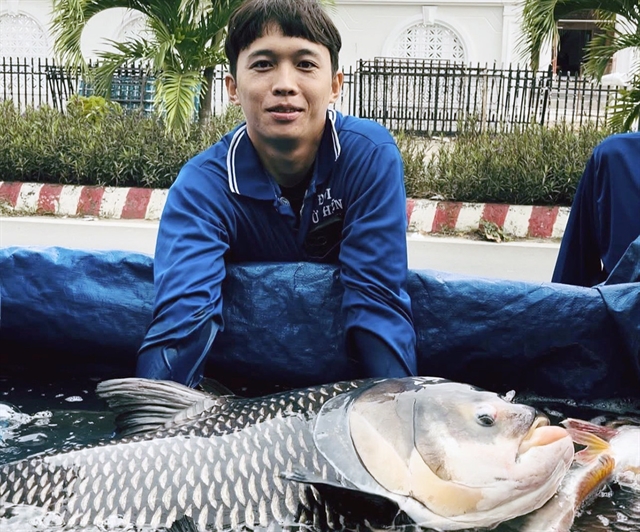 Sunday/Weekend
Sunday/Weekend

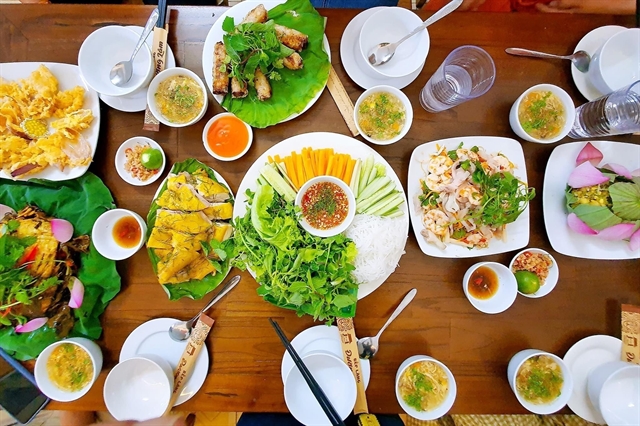 |
| LOCAL FEAST: The cuisine of Đường Lâm is characterised by its simplicity, use of local ingredients, and exquisite flavours that have stood the test of time. VNA/VNS Photo |
By Đinh Thuận & Lương Hương
One of the most well-preserved ancient villages in Việt Nam, Đường Lâm is renowned for its architectural charm and culinary traditions, making it a must-visit destination for any tourist to Hà Nội.
The village in an outlying district of the city boasts a wide array of traditional dishes that have been passed down through generations, reflecting the local people's deep connection to the land and their agricultural way of life.
Some of the most popular specialties here include Mông Phụ soy sauce, Mía chicken, roasted pork, and kẹo dồi (sweet peanut sausages).
Đường Lâm cuisine is characterised by its simplicity, use of local ingredients, and exquisite flavours that have stood the test of time.
On arriving at the centuries-old village, visitors will quickly come across rows of terracotta jars placed on the courtyards, creating a typically ancient Vietnamese atmosphere that seems to exist only in movies. The large jars are traditionally used for storing and fermenting soy sauce, known as tương in Vietnamese.
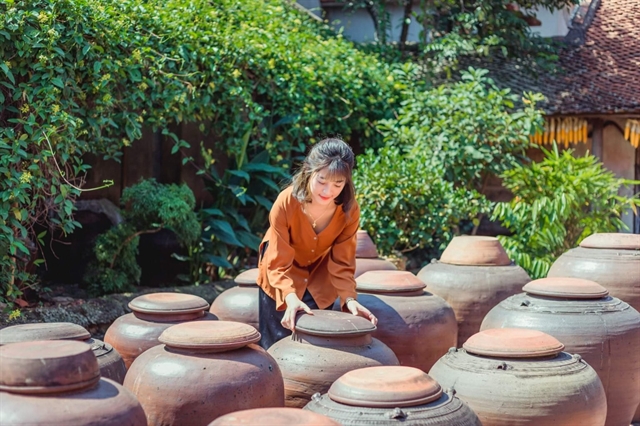 |
| ANCIENT CRAFT: Large terracotta jars are seen on the courtyards of almost all ancient houses in Đường Lâm Village. They are used to store and ferment soy sauce, known as 'tương' in Vietnamese. Photo disantrangan.vn |
One of the families that is still making tương is Hà Hữu Thể’s in Sui Hamlet. The family has been practising the traditional craft of making fermenting soy sauce for hundreds of years.
Thể’s home, a moss-covered 300-year-old wooden house with seven compartments, has been home to 13 successive generations. The family has made great efforts to not only retain the original structure of the ancient house but also their ancestors’ soy sauce-making profession.
"Every year, my family produces between 5,000 to 7,000 litres of soy sauce, supplying it to distributors and visitors,” he said.
According to Thể, the deliciousness of the sauce is created by high-quality ingredients, favourable weather conditions and the accumulated experience of the makers. Primarily, the distinct taste of soy sauce made in Đường Lâm lies in the use of the water from the Giang Well, known for its purity.
Another must-try food in Đường Lâm Village is the Mía chicken, which is renowned for its flavourful taste.
The special free-range chicken breed is named after the former name of the village – Kẻ Mía or Mía Village. These chickens were considered sacred and exclusively offered in religious ceremonies and presented to the king. Today, Mía chickens are preserved for their genetic heritage and cultivated as a high-quality farm product in the village
The chickens are raised traditionally, allowing them to roam freely and consume a natural diet. Mía chicken is also a symbolic dish representing abundance and prosperity and is often offered to the ancestors during the Lunar New Year festival, on special occasions, or in village festivals.
The meat of the chicken is best enjoyed when it has been steamed and cooled. This allows the meat to retain the savoury, fragrant, and tender flavours of the whole chicken.
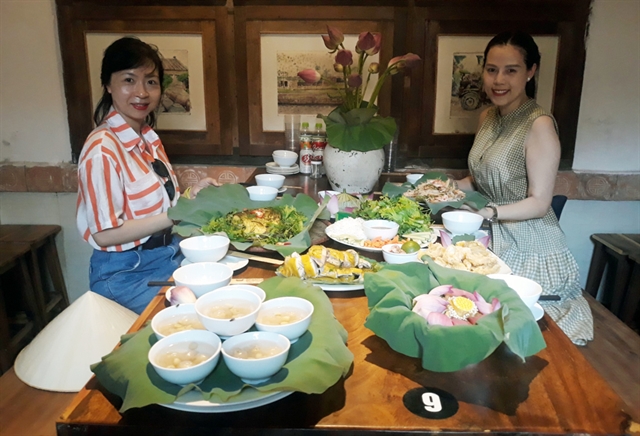 |
| RUSTIC ATMOSPHERE: Enjoying local specialties in Đường Lâm Village is an impressive experience. Photo kinhtedothi.vn |
Đường Lâm is also famed for its roast pork, which is known for its distinctive aroma and delicious flavour.
The ingredients used to make this dish include pork belly with a thick layer of skin, ground pepper, fish sauce, and, importantly, finely chopped guava leaves. The pork is marinated with just the right amount of seasoning, then wrapped tightly with bamboo strips and roasted on a charcoal fire for six hours. During this time, the skilled cook needs to focus on adjusting the heat to ensure that the meat is cooked evenly and is visually appealing.
The final product is a golden and crispy piece of meat with a layer of crackling skin that imparts an unforgettable savour. The meat itself is succulent and has a distinct flavour and eaten with salad or mixed vegetable soups that keep diners coming back for more.
Entering any ancient house in the village or a sidewalk drink stall, and tourists are often treated with a local speciality – chè lam cake, which are made of simple ingredients such as glutinous rice, mung beans, ginger, honey or sugar, and peanuts.
Along with peanut candy, chè lam is a rustic and familiar gift that embodies the essence of the Vietnamese countryside. It impresses eaters with a soft and chewy texture, with occasional bursts of sweetness from sugarcane juice and mung beans, along with the fragrant aroma of glutinous rice and fresh ginger.
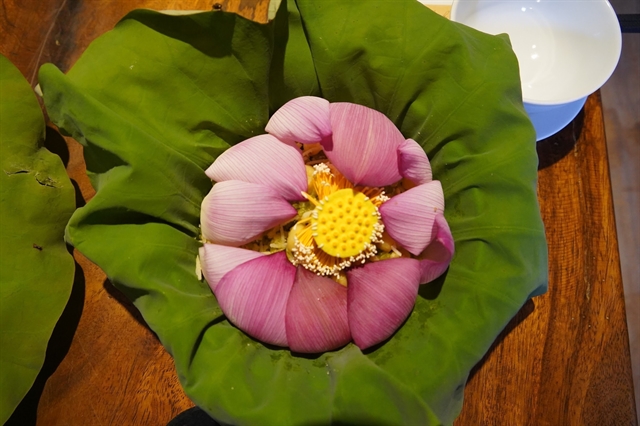 |
| FLOWERY ADDITION: Đường Lâm villagers have creatively used lotus flowers, leaves and roots as ingredients or decoration for the food. VNA/VNS Photo |
Recently, taking advantage of the local ingredients, Đường Lâm villagers have created enticing and elegant dishes known as cỗ sen (lotus feast). All the dishes use lotus as an ingredient, either directly in the preparation or as a wrapping material for the food.
A 'lotus feast' typically consists of about 10 dishes, including unique ones like fried lotus petals, lotus spring rolls, lotus chicken soup, and braised lotus roots.
Visiting the ancient village during the summer, the blooming season of lotus, visitors will have an additional captivating experience of the lotus feast, much enjoyed by Vietnamese and foreigners alike.
Maika Fukui, a tourist from Japan, said: "This is the first time I have had the opportunity to taste the lotus feast. In Japan, we also eat lotus dishes, but mainly from the root. The presentation of the feast here is beautiful, enticing, and resembles a work of art."
Culinary tours
 |
| SWEET JOB: Young tourists try making 'chè lam' cookies in Đường Lâm Village. Photo courtesy of Bếp Làng Đường Lâm |
Recognising the desire of visitors to explore the local cuisine, various tours have been launched in the ancient village, offering hands-on activities such as candy-making and traditional treats like bánh gai (sticky rice cake with mung bean fillings) and chè lam.
Tourists can also join tours of vegetable picking and visit Mía Market to shop for ingredients early in the morning and then use them to create dishes themselves like nem rán (fried spring rolls) and other Vietnamese meals.
As more and more tourists have flocked to Đường Lâm to explore its rich culinary heritage, many households now offer on-site culinary experiences where they can taste local flavours among the intimate settings of traditional houses. The dining area is modestly decorated, harmonising with the ancient background, and the traditional dishes are prepared to suit various tastes.
“Đường Lâm offers captivating landscapes, architecture, and culture, boasting a rich and delicious culinary experience, which sets the destination apart from many other tourist attractions,” said Hoàng Trung Nghĩa, a tourist from the neighbouring province of Hải Dương.
According to Nguyễn Đăng Thạo, head of the Heritage Management Board of Đường Lâm Ancient Village, the local authorities are encouraging local households with appropriate facilities to provide food services to tourists.
“In the future, we plan to expand this model to generate additional income for locals from tourism, while also meeting the culinary demands of tourists,” he said. VNS



